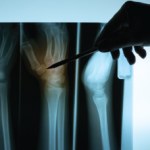For years, guidelines from various organizations have recommended osteoporosis screening in women and men starting at a specific age or based on specific risk factors. Among these guidelines are those developed by the U.S. Preventive Services Task Force (USPSTF) that recommend universal osteoporosis screening for women 65 years of age and older and for targeted screening in all women younger than 65 years with risk factors for osteoporosis.1
Despite efforts to improve utilization of osteoporosis screening, data from two recent studies confirm what is now well documented: Utilization remains woefully low, even in women following a first hip fracture.
“Our findings underscore the persistent failure to align real-world implementation of osteoporosis screening among older women with evidence-based guidelines,” says Catherine Gillespie, PhD, MPH, AARP Public Policy Institute, Washington, D.C.

Dr. Gillespie
Dr. Gillespie, along with coinvestigator Pamela E. Morin, MBA, conducted the studies to look at utilization of osteoporosis screening in two patient cohorts. Both studies looked at contemporary trends and patterns of osteoporosis screening in privately insured women in the U.S. aged 50 years and older.2,3 One study looked at utilization trends in 1,638,454 women with no prior history of osteoporosis diagnosis, drug use for osteoporosis or hip fracture.2 A second study examined trends in utilization of osteoporosis-related health services, including screening, within six to 12 months following first-time hip fracture in a cohort of 8,349 women.3
Both studies found deficiencies in how osteoporosis screening is being implemented, with each study providing important information on specific patterns of underutilization.
Primary Prevention
With the aim of describing patterns of osteoporosis screening in U.S. women aged 50 and older with no prior history of osteoporosis, Dr. Gillespie and Ms. Morin retrospectively looked at screening rates between 2008 and 2014 among 1,638,454 U.S. women grouped into three age groups: 50–64 years, 65–79 years and 80+ years.2
The study found that overall screening rates remain low in all three age groups, with 21.1% of women screening in the 50–64-year-old age group, 26.5% in the 65–79-year-old age group, and 12.8% in women aged 80 and older. However, the study found that year-over-year changes in screening utilization in two age groups were in line with national recommendations, showing that screening rates in these age groups are moving in the right direction, says Dr. Gillespie. Although still low, screening rates increased by 38% for women aged 80 and older. For women aged 50–64 years of age, screening rates decreased by 31%, which Dr. Gillespie says is in line with the Choosing Wisely campaign that recommended against universal screening for younger women given its lack of cost effectiveness.

